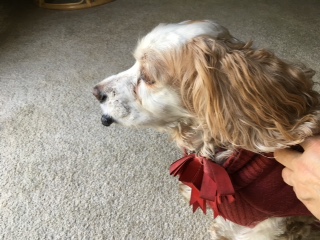Taffy, my sister’s 16-year-old cocker spaniel had several bumps around her mouth. Her vet said they were just warts and would go away on their own. But they didn’t. They got bigger and became bloody when she bumped them. Then Taffy would shake and blood spattered the walls, floor, and furniture. My sister didn’t want to perform unnecessary surgery on such an old dog, but with the bloody mess, she had no choice.
A year-and-a-half later, Taffy is fine and her warts have not returned. What could have caused them?

What causes lip warts?
Lip warts are caused by the canine oral papillomavirus. Veterinarians feel that all dogs are exposed to this virus, but only young dogs (< 2 years old), senior dogs, or dogs with compromised immune systems or on immunosuppressant drugs (like prednisone) tend to develop warts.
The papillomavirus is contagious between dogs, but humans or other animals in your house will not catch it. Typically dogs catch it from licking another dog’s mouth, or from something that an infected dog’s wart touched, like a water dish. The virus can live outside of the body for weeks, so you may not be able to determine where he was exposed.
Often dogs that are exposed will not catch the virus unless there is a break in their skin. Then it may take a month or two for the wart to develop.
Some breeds including cocker spaniels and pugs tend to be more likely to develop lip .
Once the dog has been infected with the papillomavirus, he is immune to that particular form of the virus. However, there are many different forms, some of which grow on different parts of the body, like between their toes.
Dr. Karen Becker states that the presence of warts indicates that the dog’s immune system is compromised and that there is a potential relationship between vaccinations and warts.

What do lip warts look like?
The warts are round, often pink, but sometimes black, and have a cauliflower appearance. They may stop growing once they get to a certain size. My springer, who was on chemotherapy drugs, developed several small lip warts, but these were a tenth of the size of Taffy’s.
The oral papillomavirus causes warts on the lips, tongue, gums, throat, or face.
Are warts a problem? Should I get them removed?
Typically, they do not need to be removed unless they are causing problems with eating, or like in Taffy’s case, she scraped them often and they bled. Often they will go away on their own once their body fights the infection. This may take a few months to a year.
If the warts are bleeding, infected, causing pain, or difficulty eating, then they should be removed. This usually involves surgery, although they can also be frozen off, or burned off.
There is the very rare case where the wart could grow and turn into a squamous cell carcinoma. These cells keep growing and changing –which is a strong indication that it should be checked by a veterinarian. He may want to use a fine needle aspirate for diagnosis.
Does your dog or one you know have lip warts? How were they treated?
References:
What causes dog warts? And what you should do about them https://www.petcarerx.com/article/what-causes-dog-warts/2869
All about dog warts: types, causes, and treatments https://www.petmd.com/dog/conditions/all-about-dog-warts-types-causes-and-treatments
The secret to a wart-free dog https://healthypets.mercola.com/sites/healthypets/archive/2012/10/01/dog-warts-treatment.aspx


Ah, my one Husky, Wolf, has had papillomas, not on his lip, his sister did, but he had one on his leg…which went I went in to get the fairly innocent cauliflower looking growth removed, it harbored a much larger, “babies foot” growth underneath that was not expected! My vet had never seen anything like this (I actually did a post on it with photos). Thankfully, we had it checked it out when we did. And it was just a small growth on the surface. Great awareness post!
Cookie has a little skin tag on her lip; I’m quite sure it grew as a result of some minor trauma.
Taffy gets her 15 minutes of fame!
I’m so glad that Taffy is doing better after her surgery! I can see why it would have bothered her bumping on things. Thank goodness your sister’s vet knew how to take care of them.
Hello, Great Post! I have never heard of lip warts for dogs. Sounds very similar to human warts, yuk… I would be afraid my pups would scratch them off and make them bleed and possibly spread them. I guess I would try to have them removed if that was the case.
Wow! I don’t own a dog however never even heard of such a condition. Yikes, it looks uncomfortable and alarming. Poor Taffy! I’m happy that your sister was able to have them removed and they never came back. Whew!